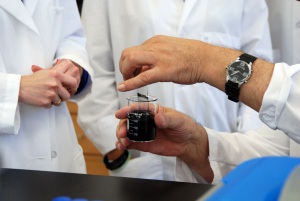Jul 9 2008
A team of researchers in Auburn University's Samuel Ginn College of Engineering has produced new antimicrobial coatings with potential to prevent diseases from spreading on contaminated surfaces - possibly solving a growing problem not only in hospitals but also in schools, offices, airplanes and elsewhere.
 A slide sample is dipped and coated as part of the process in creating the antimicrobial coatings.
A slide sample is dipped and coated as part of the process in creating the antimicrobial coatings.
Led by Virginia Davis, assistant professor in the Department of Chemical Engineering, and Aleksandr Simonian, professor of materials engineering in the Department of Mechanical Engineering, the Auburn researchers mixed solutions of lysozyme, a natural product with antimicrobial properties found in egg whites and human tears, with single-walled carbon nanotubes, or SWNTs, which are strong, microscopic pieces of carbon. SWNTs, at one nanometer in diameter, are a perfect cylinder of carbon and keep the lysozyme intact in the coating.
“Lysozyme is used in some commercial products such as Biotene mouthwash,” said Davis. “However, lysozyme itself is not as tough. Single-walled carbon nanotubes, on the other hand, are among the strongest materials known to man. While they are 100 times as strong as steel, they have only one-sixth the weight.”
By using a process called layer-by-layer deposition, the team demonstrated the inability of intact Staphylococcus aureus cells to grow on antimicrobial surfaces.
“Disinfection generally requires rigorous cleaning with solvent that must remain wet for a given period of time to ensure that surface germs are killed,” said Davis. “In contrast, we have created a surface that is inherently antimicrobial, so how long it is wet is not an issue.”
Davis’ research paper, “Strong Antimicrobial Coatings: Single-Walled Carbon Nanotubes Armored with Biopolymers,” was recently featured in NanoLetters, a premier journal in the field, frequently cited by top researchers.
“The material presented in NanoLetters is only the beginning,” said Davis. “We plan to adapt processing to enable the assembly of coatings on a much larger scale. As a foundation for future applications, the combination of single-walled carbon nanotubes with DNA, proteins and enzymes enables a range of possibilities for sensing and smart-functionality capabilities.”
Davis’ research and teaching expertise is related to SWNTs, their dispersion and shear alignment, which involves nanotube exploitation of specific properties and alignment across large spaces. She is a former student of Matteo Pasquali, associate professor of chemical and biomolecular engineering at Rice University, and Nobel Prize winner Richard E. Smalley. Simonian is a recognized expert in smart bio-functionalized materials and bio-sensing. He founded the biosensors laboratory at Yerevan Physics Institute in Armenia and serves as a member of the Auburn University Detection and Food Safety Center.
Graduate student Shankar Balasubramanian, whose expertise is in biosensors and antimicrobial materials, and postdoctoral fellow Dhriti Nepal, whose background is in SWNT-biopolymer dispersion, contributed to the project.
Davis’ paper can be read online at http://pubs.acs.org/cgi-bin/abstract.cgi/nalefd/asap/abs/nl080522t.html.